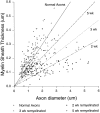Acceleration in the rate of CNS remyelination in lysolecithin-induced demyelination
- PMID: 9502810
- PMCID: PMC6793082
- DOI: 10.1523/JNEUROSCI.18-07-02498.1998
Acceleration in the rate of CNS remyelination in lysolecithin-induced demyelination
Abstract
One important therapeutic goal during CNS injury from trauma or demyelinating diseases such as multiple sclerosis is to develop methods to promote remyelination. We tested the hypothesis that spontaneous remyelination in the toxic nonimmune model of lysolecithin-induced demyelination can be enhanced by manipulating the inflammatory response. In PBS-treated SJL/J mice, the number of remyelinating axons per square millimeter of lesion area increased significantly 3 and 5 weeks after lysolecithin injection in the spinal cord. However, methylprednisolone or a monoclonal antibody (mAb), SCH94.03, developed for its ability to promote remyelination in the Theiler's virus murine model of demyelination, further increased the number of remyelinating axons per lesion area at 3 weeks by a factor of 2.6 and 1.9, respectively, but did not increase the ratio of myelin sheath thickness to axon diameter or the number of cells incorporating tritiated thymidine in the lesion. After 3 weeks, the number of remyelinating axons in the methylprednisolone or mAb SCH94.03 treatment groups was similar to the spontaneous remyelination in the 5 week PBS control-treated group, indicating that these treatments promoted remyelination by increasing its rate rather than its extent. To address a mechanism for promoting remyelination, through an effect on scavenger function, we assessed morphometrically the number of macrophages in lesions after methylprednisolone and mAb SCH94.03 treatment. Methylprednisolone reduced the number of macrophages, but SCH94.03 did not, although both enhanced remyelination. This study supports the hypothesis that even in toxic nonprimary immune demyelination, manipulating the inflammatory response is a benefit in myelin repair.
Figures






Similar articles
-
A monoclonal natural autoantibody that promotes remyelination suppresses central nervous system inflammation and increases virus expression after Theiler's virus-induced demyelination.Int Immunol. 1996 Jan;8(1):131-41. doi: 10.1093/intimm/8.1.131. Int Immunol. 1996. PMID: 8671597
-
Enhancement of central nervous system remyelination in immune and non-immune experimental models of demyelination.Mult Scler. 1997 Apr;3(2):76-9. doi: 10.1177/135245859700300203. Mult Scler. 1997. PMID: 9291157 Review.
-
E6020, a synthetic TLR4 agonist, accelerates myelin debris clearance, Schwann cell infiltration, and remyelination in the rat spinal cord.Glia. 2017 Jun;65(6):883-899. doi: 10.1002/glia.23132. Epub 2017 Mar 2. Glia. 2017. PMID: 28251686 Free PMC article.
-
Monoclonal autoantibodies promote central nervous system repair in an animal model of multiple sclerosis.J Neurosci. 1994 Oct;14(10):6230-8. doi: 10.1523/JNEUROSCI.14-10-06230.1994. J Neurosci. 1994. PMID: 7931575 Free PMC article.
-
The role of oligodendrocytes and oligodendrocyte progenitors in CNS remyelination.Adv Exp Med Biol. 1999;468:183-97. doi: 10.1007/978-1-4615-4685-6_15. Adv Exp Med Biol. 1999. PMID: 10635029 Review.
Cited by
-
Creatine Enhances Mitochondrial-Mediated Oligodendrocyte Survival After Demyelinating Injury.J Neurosci. 2017 Feb 8;37(6):1479-1492. doi: 10.1523/JNEUROSCI.1941-16.2016. Epub 2017 Jan 9. J Neurosci. 2017. PMID: 28069926 Free PMC article.
-
Coherent anti-Stokes Raman scattering imaging of myelin degradation reveals a calcium-dependent pathway in lyso-PtdCho-induced demyelination.J Neurosci Res. 2007 Oct;85(13):2870-81. doi: 10.1002/jnr.21403. J Neurosci Res. 2007. PMID: 17551984 Free PMC article.
-
Fibroblast growth factor signaling in oligodendrocyte-lineage cells facilitates recovery of chronically demyelinated lesions but is redundant in acute lesions.Glia. 2015 Oct;63(10):1714-28. doi: 10.1002/glia.22838. Epub 2015 Apr 22. Glia. 2015. PMID: 25913734 Free PMC article.
-
Transplantation of A2 type astrocytes promotes neural repair and remyelination after spinal cord injury.Cell Commun Signal. 2023 Feb 16;21(1):37. doi: 10.1186/s12964-022-01036-6. Cell Commun Signal. 2023. PMID: 36797790 Free PMC article.
-
Critical Role of Astrocyte NAD+ Glycohydrolase in Myelin Injury and Regeneration.J Neurosci. 2021 Oct 13;41(41):8644-8667. doi: 10.1523/JNEUROSCI.2264-20.2021. Epub 2021 Sep 7. J Neurosci. 2021. PMID: 34493542 Free PMC article.
References
-
- Arya SK, Wong-Staal F, Gallo RC. Dexamethasone-mediated inhibition of human T-cell growth factor and gamma-interferon messenger RNA. J Immunol. 1984;133:273–276. - PubMed
-
- Asakura K, Miller DJ, Murray K, Bansal R, Pfeiffer SE, Rodriguez M. Monoclonal autoantibody SCH94.03 which promotes CNS remyelination recognizes an antigen on the surface of oligodendrocytes. J Neurosci Res. 1996a;43:273–281. - PubMed
-
- Asakura K, Pogulis RJ, Pease LR, Rodriguez M. A monoclonal autoantibody which promotes central nervous system remyelination is highly polyreactive to multiple known and novel antigens. J Neuroimmunol. 1996b;65:11–19. - PubMed
-
- Bansal R, Gard AL, Pfeiffer SE. Stimulation of oligodendrocyte differentiation in culture by growth in the presence of a monoclonal antibody to sulfated glycolipid. J Neurosci Res. 1988;21:260–267. - PubMed
Publication types
MeSH terms
Substances
Grants and funding
LinkOut - more resources
Full Text Sources
Other Literature Sources
Molecular Biology Databases
